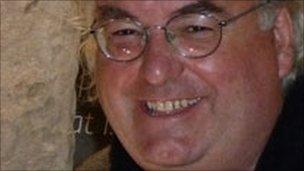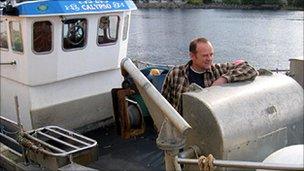Poet claims marine plans lack 'demographic involvement'
- Published

Ruined Castleton Mill is a feature of the cultural life that Gunn believes should be invested in
Poet and playwright George Gunn has warned that the north of Scotland could lose out over plans to generate electricity from the Pentland Firth.
He said there was "no sense of demographic involvement" and people were having to accept the project whether they liked it or not.
Thurso-born Gunn supports renewable energy but said people should have greater ownership of the scheme.
The Crown Estate and government said there would be public consultation.
Gunn's career has included working in the fishing and oil industries.
He has written more than 20 stage plays, including for radio, and ran the Grey Coast Theatre Company until it folded earlier this year due to a lack of funding.
His play Atomic City is about a community dealing with the imposition of a huge nuclear industrial complex and draws inspiration from the early days of the Dounreay nuclear plant, near Thurso.
Gunn said: "Renewable energy in whatever form is desirable.
"The problem I have with the renewable projects that are mooted for the Pentland Firth is what is going to be the local benefit? What is going to be the employment prospects for local people?"
Gunn, who lives in Caithness, said: "It was very difficult for small and medium companies to get a foothold in the Pentland Firth tendering process.
"The big companies have snapped it all up and what will happen is the electricity generated off our shores will bypass the north of Scotland and then be sold back to us at a high rate.
"The electricity should be used locally first and then, if profitable, be sold on the National Grid and the profits used to regenerate Caithness."
The far north has a previous record as a test site for new technology.
Dounreay was built near Thurso in the 1950s to lead UK experiments in nuclear power.
But while it brought new jobs to an area reliant on farming and fishing, Gunn said mistakes were made and were being repeated now.
He said: "The people are being bypassed once again as they were in the 1950s when Dounreay was put here.
"There is no sense of a demographic involvement with all of the people of the north of Scotland.
"Then there was no consultation of a meaningful nature. It was seen to be good for us and it was here whether we liked it or not.

Gunn has previously tackled the nuclear industry in his work
"That paternalism is apparent now I think."
He added: "The whole thing is based on models of the past - heavy industry and big is good."
'No wherewithal'
Gunn said the establishment had focused too exclusively on its own economic agenda for the area. Other assets - the north's arts and culture - had been ignored, he said.
The Caithness landscape and history have been shaped by its Neolithic inhabitants, the Vikings - Thurso takes its name from the Norse god Thor - through to the two world wars.
A record number of brochs - 2,000-year-old stone towers - have been found in the area.
Imposing and ruined early 19th Century Castleton Mill is one of only two examples of a double mill in Scotland, the other being Ayre Mill in Kirkwall.
Caithness like neighbouring Sutherland was also marked by the Highland Clearances.
But Gunn said it was as if this rich past was a secret and Caithness's ancient relics were forgotten while sites on Orkney across the firth draw thousands of visitors.
He said: "Caithness has been used as a highway to the pier in order for tourists to go to Orkney.
"For every fantastic thing that is in Orkney there are probably about four in Caithness, but they are just lying under layers of peat.
"The archaeologists know they are there, but there is just no wherewithal to dig them up or promote them.
"The amount of Neolithic, Iron Age and Bronze Age sites here is quite fantastic, especially around Yarrows and Ulbster."
He added: "The trick the establishment is missing, and it is because they don't value cultural life, is that this is a time for a place like the north of Scotland to invest in the arts and the cultural life of the area.
"The bottom line is if there is no involvement with local people whether it is in economic life, or cultural life, what you are going to face over the next 10 years is drastic depopulation.
"Those aged between 16 and 35 will go first and we will be left with an elderly population that is economically moribund.
"That is not a prospect that I savour."
'Last forever'
Shellfish fisherman Jay Mackay, who lives in Halkirk and fishes out of Inverness, sees good and bad in the chase for marine renewables.
Like Gunn, he is in favour of greener power and harbours hopes that the industry could one day offer employment to his children.
Mr Mackay has fished for crab and lobster off the Highlands' east and north coasts for the last 30 years.

Jay Mackay hopes renewables will create jobs for his children's generation
He said: "A lot of people are hopeful about renewable energy from the firth because it is something that could last forever.
"It is not something that will run out like oil and coal.
"But it is going to be a steep learning curve and I don't think they have got the technology yet to fix down devices in some of the places in the Pentland Firth they are talking about."
The fisherman said the firth's waters could be "violent" and slack times for anchoring barges and deploying devices could last for as little as an hour.
Mr Mackay said: "The tide going against the wind causes a lot of the motion in the firth and a lot of Atlantic swell comes down through it as well. It's a severe place."
Left drifting
Lost lengths of rope, rubbish and other debris churn around in the stretch of water.
In 2008, a Norwegian fishing boat lost a net the length of about six football pitches.
It was so big that the Maritime and Coastguard Agency issued a warning to vessels in the Pentland Firth to beware.
The Buckie-registered Aubretia was left drifting without power after catching its propeller on the net.
Mr Mackay said: "The net went back and fore through the firth before it was shredded by the tide.
"Rubbish could be a threat to these multi-million pound devices and then there is the problem with recovering them so repairs can be carried out."
The fisherman believes fishing and marine renewables can co-exist, but was in no doubt who would win if their interests were to clash.
He said: "Government is determined to get these devices put in place.
"Is it going to be one or two fishermen being displaced or a multi-million company creating energy who is going to win in the eyes of government?"
The Crown Estate, which has leased out areas of the seabed for wave and tidal projects, said public views would be sought.
Development manager John Robertson said: "It is crucial that residents are consulted on proposals for marine energy projects in the Pentland Firth and Orkney waters.
"The Crown Estate and other organisations involved will be holding a series of events and activities, starting with public exhibitions in November in Thurso and Kirkwall."
The Scottish government said it had held informal consultation on its plans.
A spokeswoman said: "The Scottish government recognises the need to ensure that these wave and tidal developments are taken forward in a way that avoids conflicts with other users of the sea and that protects the marine environment."
She added: "The Scottish government is developing a marine spatial plan in the Pentland Firth and Orkney Waters area, and this will inform marine renewable decisions.
"We held an informal public consultation earlier on this year, to help the local communities and stakeholders understand the purpose of the plan, and the process by which it will be developed.
"Full consultation will take place on the draft plan once it is developed."
- Published12 October 2010
- Published12 October 2010